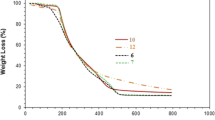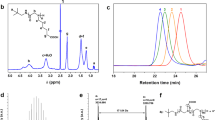Abstract
Monomer pairs, dimethyl N,N-diallylaspartate hydrochloride [(CH2=CH–CH2)2NH+CH(CO2Me)CH2CO2Me Cl−] (I)/SO2 and N,N-diallylaspartic acid hydrochloride [(CH2=CH-CH2)2NH+CH(CO2H)CH2CO2H Cl−] (II)/SO2, underwent alternate cyclocopolymerization to give cationic polyelecyrolytes (CPEs), poly(I-alt-SO2) (III) and poly(II-alt-SO2) (IV), respectively, in very good yields. (+) III upon acid hydrolysis was converted to cationic (+) IV, bearing in each repeating unit the triprotic acid residues [(NH+…(CO2H)2] of aspartic acid hydrochloride. Under the influence of pH, (+) IV has been equilibrated to water-insoluble diprotic polyzwitterionic acid (±) V, water-soluble monoprotic poly(zwitterion-anion) (± −) VI and finally its conjugate base polydianion (=) VII. Basicity constants of CO2 − and amine group have were determined. The pH-responsive polymer was demonstrated to be an efficient antiscalant against CaSO4 scaling. For potential separation and purification of biomolecules, a recyclable aqueous two-phase system (ATPS) was constructed using water-soluble (=) VII and urethanized polyvinyl alcohol; the ionic polymer can be recycled by precipitating it as (±) V at a lower pH.






Similar content being viewed by others
Reference
Krebs HA, Weitzman PDJ (1987) Krebs’ citric acid cycle: half a century and still turning. Biochemical Society, London. ISBN 0-904498-22-0
Roweton S, Huang SJ, Swift G (1997) Poly (aspartic acid)—synthesis, biodegradation, and current applications. J Environ Polym degrad 5:175–181
Rusenko KW, Donachy JE, Wheeler AP (1991) Purification and characterization of a shell matrix phosphoprotein from the american oyster. In: Sikes CS, Wheeler AP (eds) Surface reactive peptides and polymers. ACS Symposium Series 444. ACS, pp 107–124
Joentgen W, Müller N, Mitschker A, Schmidt H (2004) Polyaspartic acids. In: Fahnestock S, Steinbüchel A (eds) Polyamides and complex proteinaceous materials I. Biopolymers 7. Wiley-VCH. pp 175–179. ISBN 9783527302222
Low KC, Wheeler AP, Koskan LP (1996) 6: Commercial poly (aspartic acid) and its uses. In: Glass JE (ed) Hydrophilic polymers, advances in chemistry 248, ACS pp 99–111
Gross RA, Kalra B (2002) Biodegradable polymers for the environment. Science 297(5582):803–807
Hasson D, Shemer H, Sher A (2011) State of the art of friendly “green” scale control inhibitors: a review article. Ind Eng Chem Res 50:7601–7607
Zahuriaan-Mehr MJ, Pourjavadi A, Salimi H, Kurdtabar M (2009) Protein-and homo poly (amino acid)-based hydrogels with super-swelling properties. Polym Adv Technol 20:655–671
Thombre SM, Sarwade BD (2005) Synthesis and biodegradability of polyaspartic acid: a critical review. J Macromol Sci Part A 42:1299–1315
Liu M, Wang L, Su H, Cao H, Tan T (2013) pH-sensitive IPN hydrogel based on poly (aspartic acid) and poly (vinyl alcohol) for controlled release. Polym Bull 70:2815–2827
Butler GB (1992) Cyclopolymerization and cyclocopolymerization. Marcel Dekker, New York
Ali SA, Zaidi SMJ, El-Sharif AMZ, Al-Taq Ali A (2012) Cyclopolymers from N, N-Diallyl-N-propargyl-(12-N′-formylamino)-1-dodecylammonium chloride and Their use as Inhibitors for mild steel corrosion. Polym Bull 69:491–507
Kudaibergenov S, Jaeger W, Laschewsky A (2006) Polymeric betaines: synthesis, characterization, and application. Adv Polym Sci 201:157–224
Singh PK, Singh VK, Singh M (2007) Zwitterionic polyelectrolytes: a review. E-Polymers 030:1–34
Jamiu ZA, Al-Muallem HA, Ali SA (2015) Aspartic acid in a new role: synthesis and application of a pH-responsive cyclopolymer containing residues of the amino acid. React Func Polym 93:120–129
Al-Muallem HA, Wazeer MIM, Ali SA (2002) Synthesis and solution properties of a new pH-responsive polymer containing amino acid residues. Polymer 43:4285–4295
Albertsson P (1986) Partition of cell particles and macromolecules, 3rd edn. Wiley, Newyork
Waziri M, Abu-Sharkh BF, Ali SA (2004) Protein partitioning in aqueous two-phase systems composed of a pH-responsive copolymer and poly (ethylene glycol). Biotechnol Prog 20:526–532
Ali SA, Al-Hamouz OCS, Hassan NM (2013) Novel cross-linked polymers having pH-responsive amino acid residues for the removal of Cu2+ from aqueous solution at low concentrations. J Hazard Mater 248–249:47–58
Ali SA, Al-Muallem HA, Mazumder MAJ (2013) Coexistence curves of aqueous two-phase systems of some pH-responsive homo- and copolymers of 3-(diallylammonio)propane-1-sulfonate and urethanized poly (ethenol) or poly (oxyethylene). J Chem Eng Data 58:2574–2585
Andrews BA, Asenjo JA (2010) Theoretical and experimental evaluation of hydrophobicity of proteins to predict their partitioning behavior in aqueous two phase systems: a review. Sep Sci Technol 45:2165–2170
Ali SA, Abu-Thabit NY, Al-Muallem HA (2010) Synthesis and solution properties of a pH-responsive cyclopolymer of zwitterionic ethyl 3-(N, N-diallylammonio) propanephosphonate. J Polym Sci Part A Polym Chem 48:5693–5703
Haladu SA, Ali SA (2013) A pH-responsive cyclopolymer having phospho- and sulfopropyl pendents in the same repeating unit: synthesis, characterization, and its application as an antiscalant. J Polym Sci Part A Polym Chem 51:5130–5142
Rullens F, Devillers M, Laschewsky A (2004) New regular, amphiphilic poly (ampholyte)s: synthesis and characterization. Macromol Chem Phys 205:1155–1166
Wielema TA, Engberts JBFN (1987) Zwitterionic polymers—I. Synthesis of a novel series of poly (vinylsulphobetaines). Effect of structure of polymer on solubility in water. Eur Polym J 23:947–950
Salamone JC, Volksen W, Olson AP, Israel SC (1978) Aqueous solution properties of a poly (vinyl imidazolium sulphobetaine). Polymer 19:1157–1162
Yoshizawa M, Ohno H (1999) Molecular brush having molten salt domain for fast ion conduction. Chem Lett 889–890
Laschewsky A (2014) Structures and synthesis of zwitterionic polymers. Polymers 6:1544–1601
Pearson JF, Slifkin MA (1972) The infrared spectra of amino acids and dipeptides. Spectrochim Acta A 28A:2403–2413
Butler GB, Angelo RJ (1957) Preparation and polymerization of unsaturated quaternary ammonium compounds. VIII. A proposed alternating intramolecular–intermolecular chain propagation1. J Am Chem Soc 79:3128–3131
Pike RM, Cohen RA (1960) Organophosphorus polymers. I. Peroxide-initiated polymerization of diethyl and diisopropyl vinylphosphonate. J Polym Sci 44:531–538
Barbucci R, Casolaro M, Danzo N, Barone V, Ferruti P, Angeloni A (1983) Effect of different shielding groups on the polyelectrolyte behavior of polyamines. Macromolecules 16:456–462
Davey RJ (1982) The role of additives in precipitation processes. In: Jancic SJ, de Jong EJ (eds) Industrial crystallization 81. North-Holland, Amstardam, pp 123–135
Diamond AD, Hsu JT (1992) Correlation of polymer partitioning in aqueous two-phase systems. AIChE Symp Ser 290:105–111
Shahriari S, Doozandeh SG, Pazuki G (2012) Partitioning of cephalexin in aqueous two-phase systems containing poly (ethylene glycol) and sodium citrate salt at different temperatures. J Chem Eng Data 57:256–262
Zhang Y, Zhou Y, Liu C (2014) Structure and properties of novel blend films from alginate and quaternized poly(4-vinyl-N-carboxymethylpyridine) containing zwitterion structure units. Polym Bull 71:2014
Acknowledgments
This project was funded by the National Plan for Science, Technology and Innovation (MAARIFAH), King Abdulaziz City for Science and Technology, through the Science & Technology Unit at King Fahd University of Petroleum & Minerals (KFUPM), the Kingdom of Saudi Arabia, award number (11-ADV2132-04). The authors gratefully acknowledge the facilities provided by KFUPM.
Author information
Authors and Affiliations
Corresponding author
Rights and permissions
About this article
Cite this article
Ali, S.A., Jamiu, Z.A. Poly(N,N-diallylaspartic acid-alt-sulfur dioxide): its synthesis and application. Polym. Bull. 73, 2179–2198 (2016). https://doi.org/10.1007/s00289-016-1602-x
Received:
Revised:
Accepted:
Published:
Issue Date:
DOI: https://doi.org/10.1007/s00289-016-1602-x




